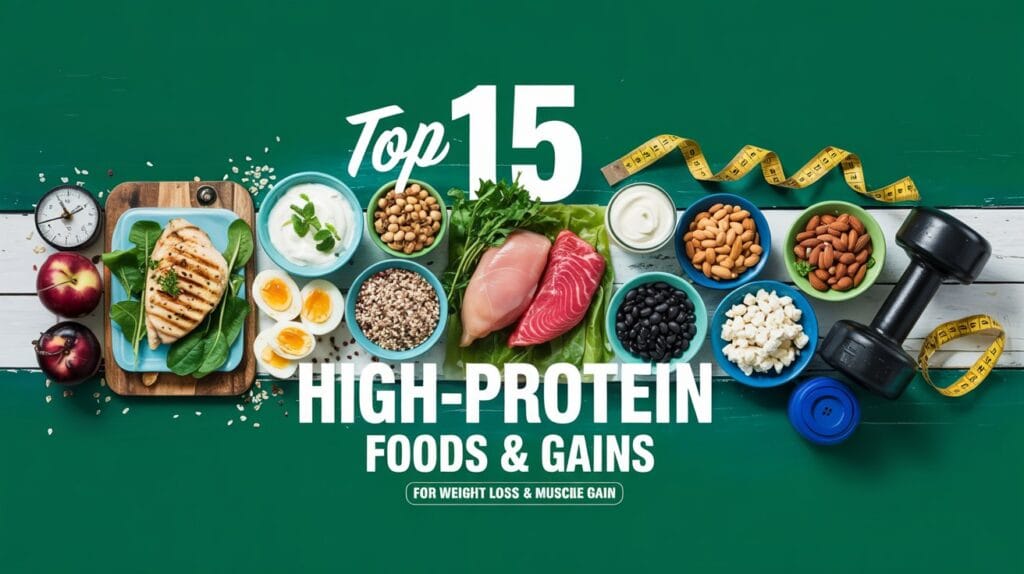When you’re on a mission to achieve your health goals, build muscle, and lose weight, there’s one nutrient you absolutely can’t ignore: PROTEIN.
High-protein foods into your routine help with weight loss and muscle gain can improve body composition, energy levels, and satiety.
🔍 Why Focus on High-Protein Foods?
Protein plays an essential role for repairing tissues, building muscles, and boosting metabolism. It also keeps you full longer than carbs and fat. That’s why It’s no surprise that searches like “high protein low calorie foods” and “foods high in protein” have surged on Google Trends.
Let’s checkout the top 15 foods that are not only rich in protein but also packed with additional nutrients that support your overall health and easy to add to your daily diet.
Top 15 Protein-Packed Foods to Fuel Your Body
1. Skinless Chicken Breast
A lean source of protein in any fitness diet, easy to prep, that’s versatile and low in calories.
Protein: ~31g per 100g
2. Non-Fat Greek Yogurt
Loaded with twice the protein and probiotics as regular yogurt. A great swap for sour cream or dessert toppings.
Protein: ~10g per 100g
3. Cooked Lentils
An excellent plant-based protein, fiber-rich legume that’s perfect for soups, salads, and curries.
Protein: ~9g per 100g
4. Whole Eggs
Budget-friendly and nutrient-dense. A complete protein source that supports muscle recovery. You can keep the yolk for added vitamins
Protein: ~6g per egg
5. Low-Fat Cottage Cheese
Low in fat, high in protein, and great for late-night snacking, meal prep, or even blending into smoothies.
Protein: ~11g per 100g
6. Firm Tofu
A go-to for vegetarians and vegans. Absorb flavors beautifully in curries.
Protein: ~8g per 100g
7. Tinned Tuna in Water
Budget-friendly and perfect for quick meals. A perfect pantry item.
Protein: ~25g per 100g
8. Steamed Edamame
A complete plant protein, great tasty snack loaded with protein and fiber.
Protein: ~11g per 100g
9. Turkey Breast
Lean, low in fat, satisfying, and perfect for wraps or sandwiches.
Protein: ~29g per 100g
10. Tempeh
Fermented soy with a nutty flavor packed with protein and beneficial for gut health.
Protein: ~19g per 100g
11. Cooked Quinoa
A complete plant-based protein with all 9 essential amino acids.
Protein: ~4g per 100g
12. Almonds
Great for snacks or adding crunch to meals.
Protein: ~6g per 28g (1 oz)
13. Natural Peanut Butter
Pair it with apple slices or spread it on whole-grain toast. Delicious and calorie-dense—just watch your portions.
Protein: ~8g per 2 tbsp
14. Whey or Plant-Based Protein Powder
Convenient and versatile for shakes or baking. Perfect post-workout or in your morning smoothie.
Protein: ~20–25g per scoop
15. Black Beans
Affordable, fiber-rich, heart-healthy, and perfect in bowls or tacos.
Protein: ~9g per 100g
Easy Meals Using High-Protein Foods
- Grilled chicken with quinoa and steamed broccoli
- Greek yogurt parfait with berries and almonds
- Lentil soup with whole-grain toast
- Tofu stir-fry with brown rice and vegetables
- Tuna salad with chickpeas and leafy greens
- Egg scramble with tofu and spinach
- Protein smoothie with almond milk, banana, and protein powder
- Black bean and lentil soup with garlic toast
📈 What People Are Searching/Looking For:
Based on recent Google Trends data, people are highly interested in:
- Foods high in protein
- Highprotein, low calorie foods
- Highfiber, high protein foods
- What are high protein foods
Final Tips
- Aim for 20–30g of protein per meal.
- Include a mix of animal and plant-based proteins.
- Stay hydrated—protein metabolism requires water.
- Don’t forget to use tools like our Calorie Calculator or BMI Calculator to track your goals!
Conclusion
If you’re serious about improving your body composition and energy levels, adding more high-protein foods to your diet is the key. From classic staples like chicken and tuna to plant-based heroes like lentils and tofu, there’s something on this list for everyone. All you need to do is:
Start small—swap one meal a day with a high-protein alternative and build from there.


Pingback: Best Time to Drink Protein Shake—What You Should Know